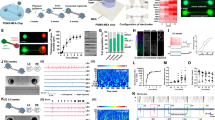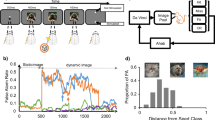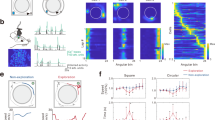Abstract
The primary somatosensory cortex (S1) contains a complete body map that mirrors the subcortical maps developed by peripheral sensory input projecting to the sensory hindbrain, the thalamus and then S1. Peripheral changes during development alter these maps through 'bottom-up' plasticity. Unknown is how S1 size influences map organization and whether an altered S1 map feeds back to affect subcortical maps. We show that the size of S1 in mice is significantly reduced by cortex-specific deletion of Pax6, resulting in a reduced body map and loss of body representations by an exclusion of later-differentiating sensory thalamocortical input. An initially normal sensory thalamus was repatterned to match the aberrant S1 map by apoptotic deletion of thalamic neurons representing body parts with axons excluded from S1. Deleted representations were rescued by altering competition between thalamocortical axons using sensory deprivation or increasing the size of S1. Thus, S1 size determined the resolution and completeness of body maps and engaged 'top-down' plasticity that repatterned the sensory thalamus to match S1.
This is a preview of subscription content, access via your institution
Access options
Subscribe to this journal
Receive 12 print issues and online access
$209.00 per year
only $17.42 per issue
Buy this article
- Purchase on Springer Link
- Instant access to full article PDF
Prices may be subject to local taxes which are calculated during checkout








Similar content being viewed by others
References
Kaas, J.H. The evolution of complex sensory systems in mammals. J. Exp. Biol. 146, 165–176 (1989).
Krubitzer, L. & Kahn, D.M. Nature versus nurture revisited: an old idea with a new twist. Prog. Neurobiol. 70, 33–52 (2003).
Erzurumlu, R.S., Murakami, Y. & Rijli, F.M. Mapping the face in the somatosensory brainstem. Nat. Rev. Neurosci. 11, 252–263 (2010).
Erzurumlu, R.S. & Gaspar, P. Development and critical period plasticity of the barrel cortex. Eur. J. Neurosci. 35, 1540–1553 (2012).
Krubitzer, L.A. & Seelke, A.M. Cortical evolution in mammals: the bane and beauty of phenotypic variability. Proc. Natl. Acad. Sci. USA 109 (suppl. 1): 10647–10654 (2012).
Krubitzer, L. & Kaas, J. The evolution of the neocortex in mammals: how is phenotypic diversity generated? Curr. Opin. Neurobiol. 15, 444–453 (2005).
Krubitzer, L. In search of a unifying theory of complex brain evolution. Ann. NY Acad. Sci. 1156, 44–67 (2009).
Woolsey, T.A. & Van der Loos, H. The structural organization of layer IV in the somatosensory region (SI) of mouse cerebral cortex. The description of a cortical field composed of discrete cytoarchitectonic units. Brain Res. 17, 205–242 (1970).
Van Der Loos, H. Barreloids in mouse somatosensory thalamus. Neurosci. Lett. 2, 1–6 (1976).
Ma, P.M. & Woolsey, T.A. Cytoarchitectonic correlates of the vibrissae in the medullary trigeminal complex of the mouse. Brain Res. 306, 374–379 (1984).
Belford, G.R. & Killackey, H.P. The sensitive period in the development of the trigeminal system of the neonatal rat. J. Comp. Neurol. 193, 335–350 (1980).
Durham, D. & Woolsey, T.A. Effects of neonatal whisker lesions on mouse central trigeminal pathways. J. Comp. Neurol. 223, 424–447 (1984).
Feldman, D.E., Nicoll, R.A. & Malenka, R.C. Synaptic plasticity at thalamocortical synapses in developing rat somatosensory cortex: LTP, LTD, and silent synapses. J. Neurobiol. 41, 92–101 (1999).
Fox, K. & Wong, R.O. A comparison of experience-dependent plasticity in the visual and somatosensory systems. Neuron 48, 465–477 (2005).
Fox, K. Barrel Cortex (Cambridge University Press, 2008).
Andrews, T.J., Halpern, S.D. & Purves, D. Correlated size variations in human visual cortex, lateral geniculate nucleus, and optic tract. J. Neurosci. 17, 2859–2868 (1997).
White, L.E. et al. Structure of the human sensorimotor system. II: lateral symmetry. Cereb. Cortex 7, 31–47 (1997).
Dougherty, R.F. et al. Visual field representations and locations of visual areas V1/2/3 in human visual cortex. J. Vis. 3, 586–598 (2003).
Higginbotham, H., Yokota, Y. & Anton, E.S. Strategies for analyzing neuronal progenitor development and neuronal migration in the developing cerebral cortex. Cereb. Cortex 21, 1465–1474 (2011).
Rubenstein, J.L. Annual research review: development of the cerebral cortex: implications for neurodevelopmental disorders. J. Child Psychol. Psychiatry 52, 339–355 (2011).
Leingärtner, A. et al. Cortical area size dictates performance at modality-specific behaviors. Proc. Natl. Acad. Sci. USA 104, 4153–4158 (2007).
Zhou, L. et al. Maturation of “neocortex isole” in vivo in mice. J. Neurosci. 30, 7928–7939 (2010).
O'Leary, D.D., Chou, S.J. & Sahara, S. Area patterning of the mammalian cortex. Neuron 56, 252–269 (2007).
Bishop, K.M., Goudreau, G. & O'Leary, D.D. Regulation of area identity in the mammalian neocortex by Emx2 and Pax6. Science 288, 344–349 (2000).
Ashery-Padan, R., Marquardt, T., Zhou, X. & Gruss, P. Pax6 activity in the lens primordium is required for lens formation and for correct placement of a single retina in the eye. Genes Dev. 14, 2701–2711 (2000).
Gorski, J.A. et al. Cortical excitatory neurons and glia, but not GABAergic neurons, are produced in the Emx1-expressing lineage. J. Neurosci. 22, 6309–6314 (2002).
Chou, S.J., Perez-Garcia, C.G., Kroll, T.T. & O'Leary, D.D. Lhx2 specifies regional fate in Emx1 lineage of telencephalic progenitors generating cerebral cortex. Nat. Neurosci. 12, 1381–1389 (2009).
Piñon, M.C., Tuoc, T.C., Ashery-Padan, R., Molnar, Z. & Stoykova, A. Altered molecular regionalization and normal thalamocortical connections in cortex-specific Pax6 knock-out mice. J. Neurosci. 28, 8724–8734 (2008).
Petersen, C.C. The functional organization of the barrel cortex. Neuron 56, 339–355 (2007).
Diaz, F. Cytochrome c oxidase deficiency: patients and animal models. Biochim. Biophys. Acta 1802, 100–110 (2010).
Diaz, F., Garcia, S., Padgett, K.R. & Moraes, C.T. A defect in the mitochondrial complex III, but not complex IV, triggers early ROS-dependent damage in defined brain regions. Hum. Mol. Genet. 21, 5066–5077 (2012).
Hüttemann, M. et al. Regulation of mitochondrial respiration and apoptosis through cell signaling: cytochrome c oxidase and cytochrome c in ischemia/reperfusion injury and inflammation. Biochim. Biophys. Acta 1817, 598–609 (2012).
Wallace, H. & Fox, K. Local cortical interactions determine the form of cortical plasticity. J. Neurobiol. 41, 58–63 (1999).
Chou, S. et al. Geniculocortical input drives genetic distinctions between primary and higher-order visual areas. Science 340, 1239–1242 (2013).
Sapir, T. et al. Pax6 and engrailed 1 regulate two distinct aspects of renshaw cell development. J. Neurosci. 24, 1255–1264 (2004).
Grant, E., Hoerder-Suabedissen, A. & Molnar, Z. Development of the corticothalamic projections. Front. Neurosci. 6, 53 (2012).
Molnár, Z., Garel, S., Lopez-Bendito, G., Maness, P. & Price, D.J. Mechanisms controlling the guidance of thalamocortical axons through the embryonic forebrain. Eur. J. Neurosci. 35, 1573–1585 (2012).
Rhoades, R.W. et al. Development and lesion induced reorganization of the cortical representation of the rat's body surface as revealed by immunocytochemistry for serotonin. J. Comp. Neurol. 293, 190–207 (1990).
Schlaggar, B.L. & O'Leary, D.D. Early development of the somatotopic map and barrel patterning in rat somatosensory cortex. J. Comp. Neurol. 346, 80–96 (1994).
Vitalis, T. et al. Effects of monoamine oxidase A inhibition on barrel formation in the mouse somatosensory cortex: determination of a sensitive developmental period. J. Comp. Neurol. 393, 169–184 (1998).
Waite, P.M., Li, L. & Ashwell, K.W. Developmental and lesion induced cell death in the rat ventrobasal complex. Neuroreport 3, 485–488 (1992).
Courchesne, E. et al. Mapping early brain development in autism. Neuron 56, 399–413 (2007).
Voineagu, I. et al. Transcriptomic analysis of autistic brain reveals convergent molecular pathology. Nature 474, 380–384 (2011).
Courchesne, E. et al. Neuron number and size in prefrontal cortex of children with autism. J. Am. Med. Assoc. 306, 2001–2010 (2011).
Tamura, R., Kitamura, H., Endo, T., Hasegawa, N. & Someya, T. Reduced thalamic volume observed across different subgroups of autism spectrum disorders. Psychiatry Res. 184, 186–188 (2010).
Cheon, K.A. et al. Involvement of the anterior thalamic radiation in boys with high functioning autism spectrum disorders: a diffusion tensor imaging study. Brain Res. 1417, 77–86 (2011).
Yaworsky, P.J. & Kappen, C. Heterogeneity of neural progenitor cells revealed by enhancers in the nestin gene. Dev. Biol. 205, 309–321 (1999).
Soriano, P. Generalized lacZ expression with the ROSA26 Cre reporter strain. Nat. Genet. 21, 70–71 (1999).
Zembrzycki, A., Griesel, G., Stoykova, A. & Mansouri, A. Genetic interplay between the transcription factors Sp8 and Emx2 in the patterning of the forebrain. Neural Dev. 2, 8 (2007).
Rasband, W.S. ImageJ. US National Institutes of Health, Bethesda, Maryland, USA 〈http://imagej.nih.gov/ij/〉 (1997–2013).
Acknowledgements
We thank B. Higgins and H. Gutierrez for technical assistance, J. Simon (Salk Institute MultiMedia Resources) for help making Adobe Illustrator schematics, Y. Dayn (Salk Institute Transgenic Core) for help producing the nestin-Pax6TG conditional transgenic mice, K. Jones (University of Colorado) for the Emx1-IRES-cre mice, M. Goulding (Salk Institute) for the ROSA26-GAP43-eGFP mice and members of the O'Leary lab for discussion. This work was supported by US National Institutes of Health grants R01 NS31558 and R01 MH086147 and the Vincent J. Coates Chair of Molecular Neurobiology (D.D.M.O.).
Author information
Authors and Affiliations
Contributions
A.Z. and D.D.M.O. designed the study, analyzed findings, prepared figures and wrote the paper. A.Z. performed the primary experiments. S.-J.C. and D.D.M.O. designed and generated the nestin-Pax6TG conditional transgenic mice. R.A.-P. and A.S. designed and generated the Pax6 cKO mice. All authors read and approved the final manuscript.
Corresponding author
Ethics declarations
Competing interests
The authors declare no competing financial interests.
Supplementary information
Supplementary Figures and Text
Supplementary Figures 1–6 (PDF 7802 kb)
Rights and permissions
About this article
Cite this article
Zembrzycki, A., Chou, SJ., Ashery-Padan, R. et al. Sensory cortex limits cortical maps and drives top-down plasticity in thalamocortical circuits. Nat Neurosci 16, 1060–1067 (2013). https://doi.org/10.1038/nn.3454
Received:
Accepted:
Published:
Issue Date:
DOI: https://doi.org/10.1038/nn.3454
This article is cited by
-
Moschus ameliorates glutamate-induced cellular damage by regulating autophagy and apoptosis pathway
Scientific Reports (2023)
-
Mapping GPR88-Venus illuminates a novel role for GPR88 in sensory processing
Brain Structure and Function (2018)
-
Prenatal thalamic waves regulate cortical area size prior to sensory processing
Nature Communications (2017)
-
Zbtb20 modulates the sequential generation of neuronal layers in developing cortex
Molecular Brain (2016)
-
Formation of functional areas in the cerebral cortex is disrupted in a mouse model of autism spectrum disorder
Neural Development (2015)



